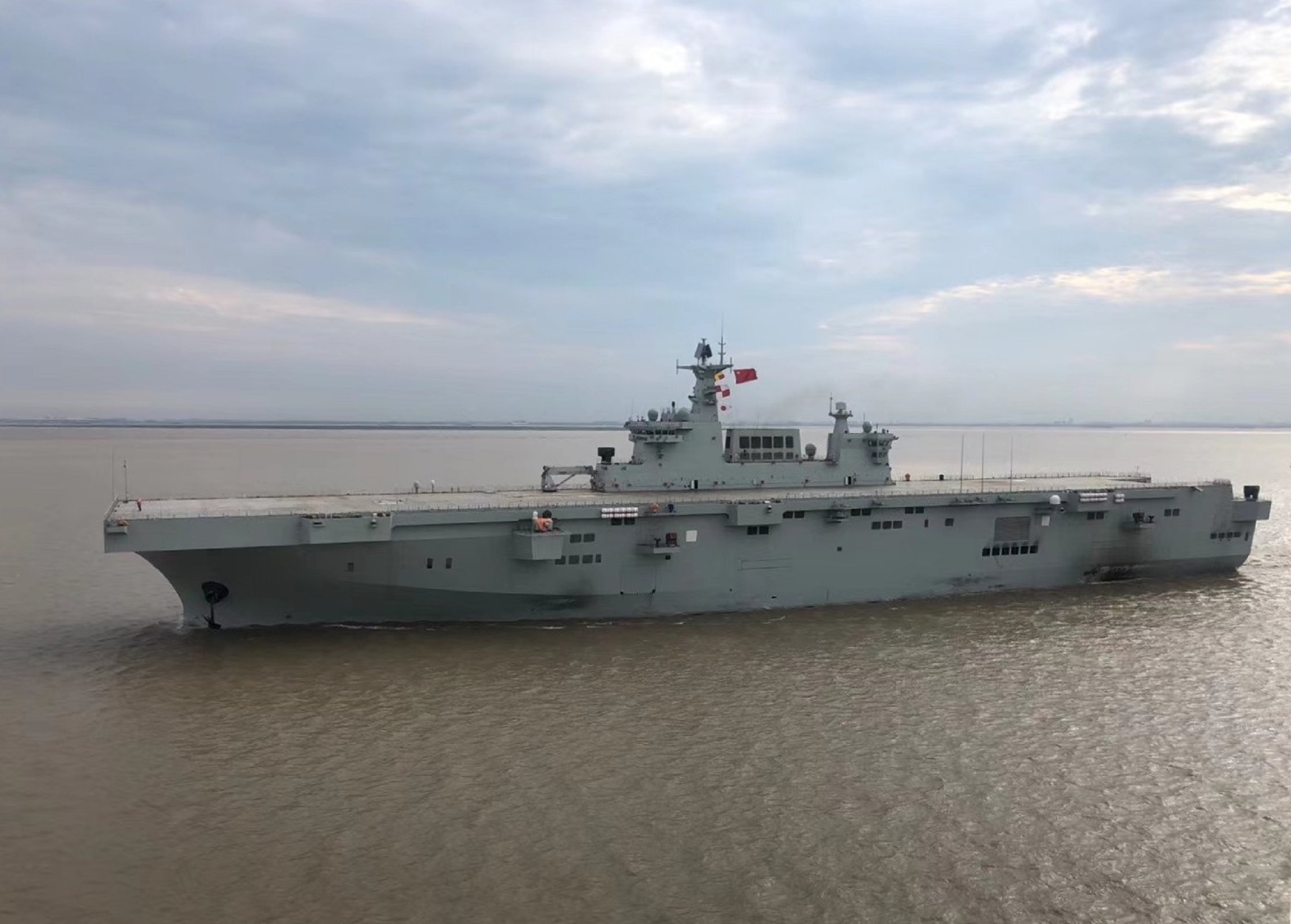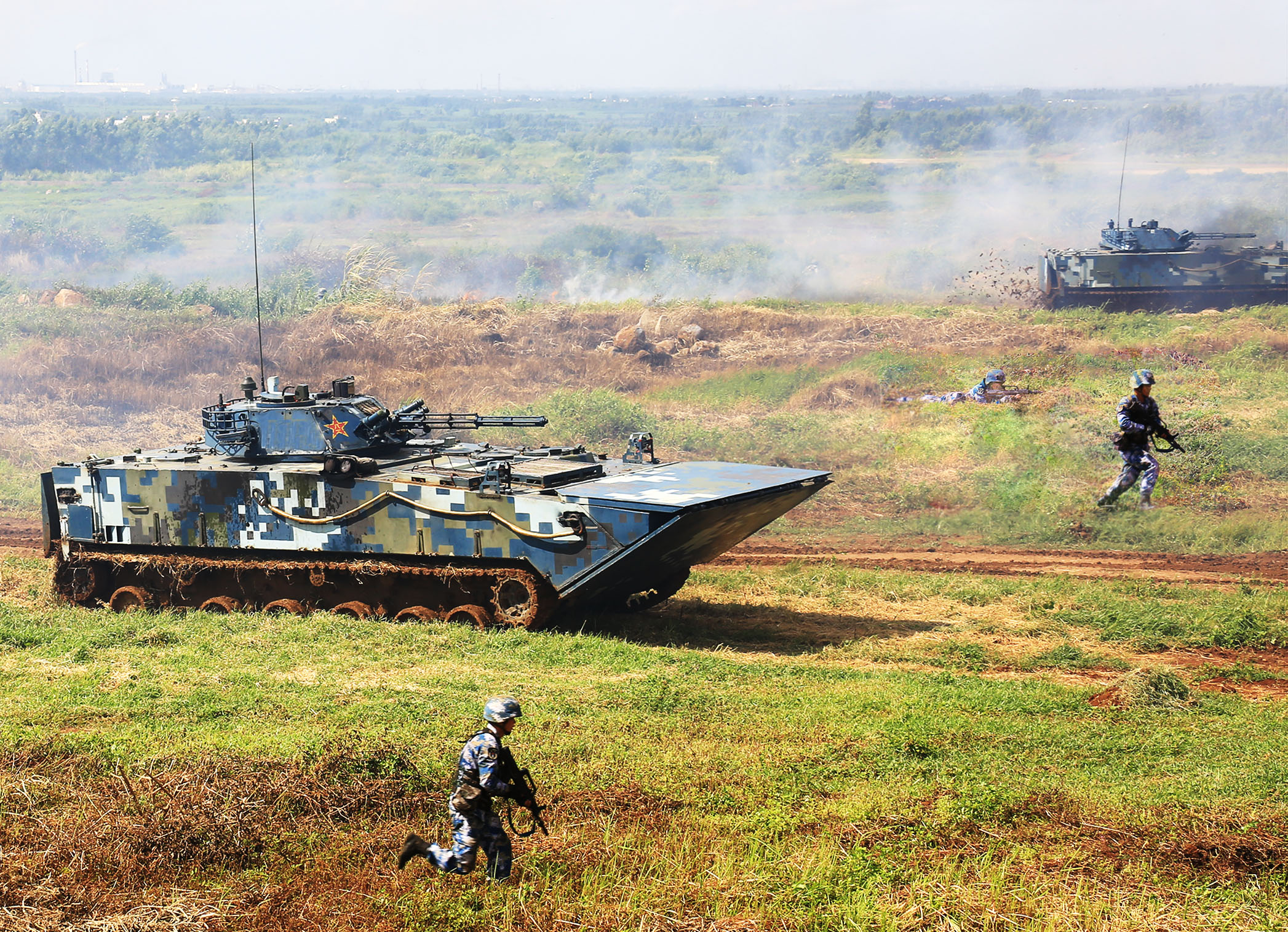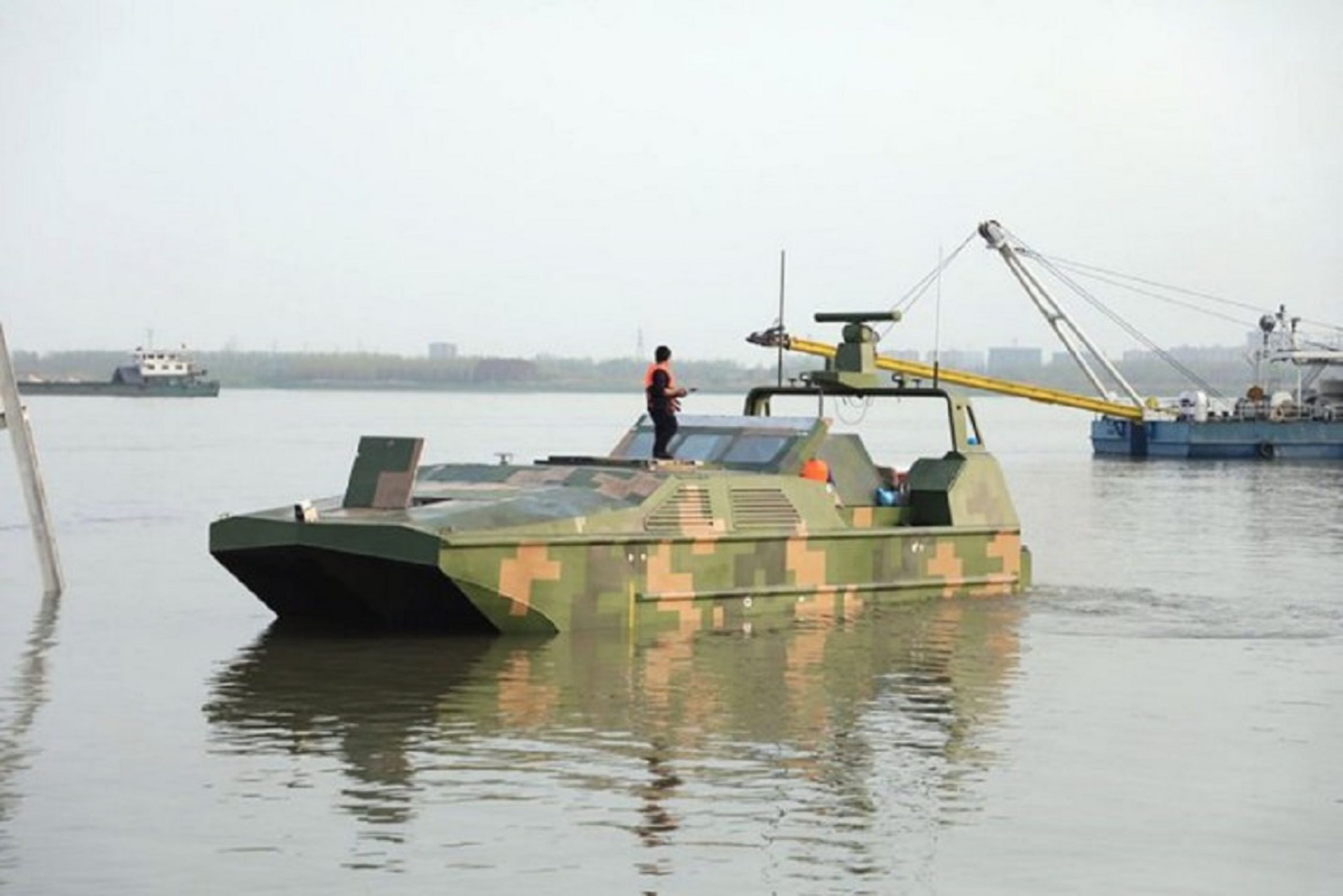To what extent has the Chinese Navy (PLAN) extended its capacity to conduct offensive amphibious operations?
Once largely aimed at constraining an adversary’s ability to approach and operate off the Chinese mainland’s coastal waters, the modernisation priorities of the People’s Liberation Army (PLA) have evidently shifted to power projection in recent years.
This intent has been telegraphed by China’s latest defence white paper released in July 2019, which described how the PLA Navy (PLAN) is expanding its mission from “defence on the near seas” to “protection missions on the far seas.”
According to the 2020 China Military Power Report published by the U.S. Department of Defense (DoD), the PLAN is now the numerically largest navy in the world with approximately 350 surface and underwater platforms, including 130 major surface combatants. This enables the service to operate at much greater distances from the mainland than previously possible.
The PLA Marine Corps (PLAMC) is widely seen to hold a privileged position within the vast Chinese armed forces because of its prominent role in asserting dominance in the South China Sea (SCS). As a result of this unique remit, the service has in recent years received greater attention in terms of funding, equipment, and higher-quality recruits than many of the other PLA forces.
The DoD also notes that the PLAN is responsible for organising, manning, training, and equipping the PLA’s naval and naval aviation forces as well as the PLA Marine Corps (PLAMC), which is subordinate to the Navy. Currently, the PLAN is believed to be capable of landing division-sized formations through amphibious operations.
A significant expansion of the PLAMC was initiated around 2017 following the transfer of four brigades from the PLA Ground Force (PLAGF) to supplement the two existing brigades at that time, which increased the size of the PLAMC from around 13,000 to an estimated 36,000 personnel.
Amphibious aims
In particular, the DoD pointed out that China’s sustained investment in amphibious warfare platforms such as helicopter and troop-carrying assault ships is a clear indication of its resolve to boost its expeditionary capabilities. The latest example of this would be the PLAN’s new Type 075 landing helicopter dock (LHD) – also known by its NATO reporting name of Yushen-class – which displaces an estimated 36,000 tonnes and measures approximately 236 metres in length with a 36m wide flight deck. This new class of amphibious assault ships represent the second largest platforms operated by the PLAN in terms of displacement and size after its aircraft carriers.
The vessel is believed to be capable of supporting up to 30 helicopters, with six landing spots on its deck dedicated to helicopter launch and recover operations. It also features a floodable well deck that enables air-cushion landing craft and amphibious armoured vehicles to deploy directly from the ship during landing assault operations.
The rate at which it is building these large vessels is astounding. On 29 January, state-owned shipbuilder China State Shipbuilding Corporation (CSSC) launched the third Yushen LHD at its Hudong-Zhonghua shipyard in Shanghai. The completed hull was manoeuvred out of its dry dock to a pierside berth in the Huangpu River where it will undergo fitting out and further testing before being commissioned into service.
The lead ship was launched in September 2019, while the second was launched in April 2020. It is worth noting that all three Type 075 LHDs have entered the water within a timeframe of just 16 months.
The lead ship suffered an internal fire on 11 April during its fit out, although the extent of damage caused is not known. It eventually resumed sea trials in the SCS and appears to be close to its commissioning after it left the Hudong-Zhonghua shipyard and arrived at the PLAN’s new naval base on Hainan Island. The second Type 075 returned to the shipyard following the first phase of its sea trials, which commenced in December, and is likely to undergo further testing.

It is believed that the ships will eventually embark a new rotary wing unmanned aerial vehicle (UAV) that could provide organic tactical intelligence, surveillance, and reconnaissance (ISR) support to boost amphibious assault operations. Images posted on Chinese social media clearly showed a UAV mockup on the flight deck of one of the ships.
Design cues observed on the mockup are visually comparable with the Z-series vertical take-off and landing (VTOL) UAVs manufactured by the Nanjing Research Institute on Simulation Technique (NRIST), although it appears to be considerably larger than known VTOL UAVs currently offered by the institute such as the maritime-optimised Z-5B/H.
Until the Type 075 LHDs are commissioned and fully operationalised, however, the PLAN’s core amphibious warfare capabilities currently reside in its eight in-service Type 071 (Yuzhao)-class amphibious transport docks (LPDs).
The Type 071 LPD displaces approximately 18,500 tonnes and has an estimated length of 210m featuring a stern well deck that can accommodate up to four Type 726 (Yuyi)-class assault hovercraft, each capable of carrying up to 60 tonnes of cargo or even a main battle tank (MBT) such as the PLAGF’s ZTZ-96 and ZTZ-99. Up to 60 armoured vehicles can also be transported and deployed via the same deck in lieu of the hovercraft.
Up to four Z-8 or Z-18 transport helicopters can be fitted into its hangar, although PLA Army Aviation Z-10 attack helicopters have also used the ship for exercises in recent years.
“The Yuzhao class LPDs and Yushen class [LHDs] provide the PLA with greater capacity, endurance, and more flexibility for long-range operations than the PLAN’s older landing ships, which it has reduced in number over the last decade with obsolete units being decommissioned,” the DoD observed.
While the Type 075 LHD has yet to be fully operationalised, the PLAN has already commenced studies into its next-generation amphibious assault ship commonly referred to as the Type 076. Details that have emerged to date include the possibility of an electromagnetic catapult for launching fixed-wing UAVs following reports that the CSSC’s 708 Research Institute – also known as the Marine Design and Research Institute of China (MARIC) – has requested proposals via the official Chinese military website run by the General Armament Department (GAD). Other requirements include an integrated electric propulsion system (IEPS) that comprise both diesel and gas turbine powerplants.
Amphibious combat vehicles
At the forefront of any ship-to-shore landing operation would be the Type 05 family of tracked amphibious vehicles, which comprise the ZBD-05 infantry fighting vehicle (IFV) armed with the ZPT-99 30mm autocannon and HJ-73B anti-tank guided missile (ATGM), the ZTD-05 assault vehicle armed with a 105mm low recoil gun, and complemented by armoured command and control (C2) and recovery vehicle variants.
The Type 05 IFVs are intended to be deployed at sea and swim under their own power to contested landing sites at speeds of up to 16 knots (30km), delivering up to eight fully equipped PLAMC dismounts under armour protection and providing supporting fires following disembarkation.
Ship-to-shore operations is supported by the ZTD-05 assault vehicle, which shares the same hull as the IFV variant but is instead equipped with a 105mm low recoil rifled gun. According to official specifications, the ZTD-05 is claimed to be capable of employing its main armament against stationary targets while swimming in conditions of up to Sea State 4. Armour piercing and high-explosive ordnance enables the vehicle to engage armoured vehicles and fortifications.

The final vehicular element in landing operations is PLZ-07B, which also uses a derivative of the Type 05 hull and the PLZ-07 self-propelled artillery system. The PLZ-07B is armed with a 122mm howitzer that can perform direct- and indirect-fire missions.
Once it secures a beachhead, PLAMC units would seek to establish an anti-access/area-denial (A2/AD) bubble in anticipation of follow-on forces, deploying anti-ship and air defence assets in addition to their organic armour and artillery capabilities to stymie any intervention by defending forces or their reinforcements.
Consistent with the PLA’s desire to enhance its command, control, communications, computers, intelligence, surveillance and reconnaissance (C4ISR) capabilities, the PLAGF has fielded a new amphibious armoured reconnaissance vehicle that appears to be derived from the Type 05 platform.
This unique variant, which was showcased in a September 2020 news clip by the state-owned China Central Television 7 (CCTV 7), is seen fitted with a telescopic mast mounting a sensor suite comprising an electro-optical and infrared (EO/IR) turret, a laser rangefinder, and a compact radar. The vehicle has also been fitted with a roof-mounted retractable catapult that can deploy a small UAV to boost beyond-line-of-sight situational awareness.
The CCTV 7 footage also highlighted how the imagery and video captured by the UAV is exploited to detect and identify potential threats. The data is then shared with other friendly units, which then perform targeting and combined fires to support a beach landing.
Emerging unmanned capabilities
As the PLA continues to focus on growing its ability to fight and win modern engagements, it will likely implement emerging technologies such as big data, the internet, artificial intelligence (AI), and cloud computing to make reliable automated platforms a reality. The DoD noted that this process has already begun with the PLA embracing big data analytics that fuse a variety of data to improve automation and to create a comprehensive, real-time picture.
Such capabilities are being manifested in new unmanned platforms are being developed for amphibious operations. Wuchang Shipbuilding Industry Group, a Wuhan-based subsidiary of the state-owned China Shipbuilding Industry Company (CSIC), is producing the Marine Lizard unmanned surface vehicle (USV) in collaboration with private enterprises.
The 13m long USV displaces around 14 tonnes and features a unique hybrid propulsion system that uses water jets while in the water, as well as four electrically powered tracks installed under each corner of the hull that enables it to transition onto land at travel at speeds around 10 knots (20 km/h).

According to the developers, the USV has been designed to be fully autonomous and can function as an armed ISR platform to support landing operations, although it can be configured to perform troop transport and logistical resupply missions if desired. AI-powered decision-making systems enables it to perform its missions autonomously, as well as manoeuvre around obstacles and difficult terrain without operator supervision.
The Marine Lizard has a stated payload capacity of five tonnes and can be equipped with a diverse range mission equipment, including EO/IR and radar sensors. A possible weapons configuration could include two forward-mounted remote weapon stations armed with machine guns, and a vertical launch system carrying very short-range air-defence or surface attack missiles.
One or more of these vehicles can be forward-deployed and hidden on uninhabited islands or remote facilities for as long as eight months on battery power, activating from their dormant states automatically or at pre-determined intervals to recharge its batteries using its main diesel generators or to conduct on-demand surveillance or reconnaissance missions.
There is no indication that the PLAMC has taken delivery of this USV, although imagery suggests that Wuchang Shipbuilding has constructed multiple pre-production vehicles – likely in anticipation of an impending order.
Short-to-medium term challenges
Dr Wu Shang-Su, a research fellow specialising in regional security at the S.Rajaratnam School of International Studies, told AMR that the commissioning of new ships such as the Type 071 LPD, Type-075 LHD, various amphibious fighting vehicles, and new helicopters such as Z-18 do not necessarily translate into immediate combat power.
“From the operational perspective, the modernised surface combatants and airpower to cover landing operations would be more important, because such capabilities for sea control are indispensable,” Dr Wu said, noting that the rate at which the PLAN acquires new assets will likely decrease in order to enable its forces to fully operationalise these capabilities by addressing integration and training imperatives.
“Further expansion of amphibious capacity may not be meaningful due to the limitation of escort capacity,” he added. “Furthermore, most amphibious platforms are vulnerable to countermeasures such as anti-ship missiles, sea mines, torpedoes and other munitions.”
Moreover, the Type 075 and future Type 076 assault ships require the PLAMC to operate a sizeable organic airlift capability to be truly effective. This in turn requires the acquisition of a considerable number of marinised helicopters capable of transporting troops. It was anticipated that an aviation brigade would also be formed, but there is no conclusive evidence that such a force been established.
by JR Ng











